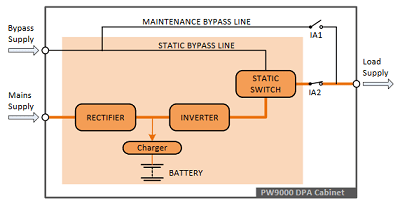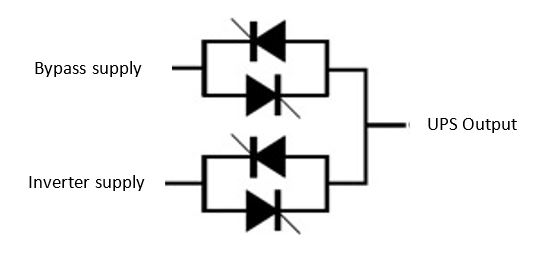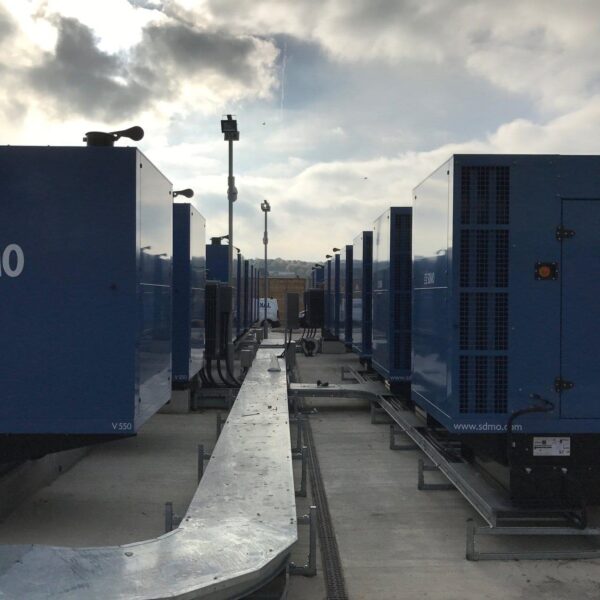KOHLER Uninterruptible Power (UPSs) are well-known as devices that can support critical loads by using stored energy during mains power blackouts. In reality though, they must also offer protection from electrical noise, spikes and surges as well as overloads and possibly even failures within themselves.
To provide protection from these various threat calls, amongst other things, static switches respond quickly to the different demands they are subjected to. In this article, Ian Jackson, General Manager at KOHLER Uninterruptible Power, explores the role of static switches and their contribution to UPS protection.
Uninterruptible power supplies (UPSs) are essential to any enterprise that depends on a continuously available IT resource for its business or processing operations – but their full contribution to IT equipment and data protection is not always entirely apparent. Wikipedia, for example, defines a UPS as ‘an electrical apparatus that provides emergency (battery) power when the mains or other input power source fails’; other sources give similar definitions.
Although there’s nothing inaccurate about this statement, it doesn’t fully reflect the UPS role. In fact, UPSs filter out many types of mains disturbances, including electrical noise and voltage sags and brownouts, spikes, surges and supply frequency changes – all of which can cause loss of data or hardware damage if allowed through to the IT equipment. UPSs must also cater for failures within themselves, although the effect of these can be minimised with redundant configurations.
While maintaining a fully-charged battery at all times is clearly critical to the UPS role, other components can be regarded as equally important. One of these is the static switch, which allows the UPS output to be transferred seamlessly between conditioned power and raw mains in response to different threats and failure modes. Below, we look at the static switch and how it contributes to UPS functionality.

Fig.1
Fig.1 shows how the static switch connects the critical load to either conditioned power from the UPS or raw mains from the bypass supply. In some installations, the bypass supply could be provided by an on-site generator. The static switch has two operational states – ‘On UPS’ and ‘On Bypass’.
The static switch typically comprises a pair of inverse parallel connected SCRs linked in series with the bypass and inverter supplies as shown in Fig.2.

Fig.2
UPS operational modes
[/vc_column_text][vc_column_text]The static switch’s role relates to the three operational modes for UPS systems; ‘on-line’, ‘off-line’ and ‘line-interactive’. Products such as KOHLER Uninterruptible Power’ KOHLER PW 9000DPA can operate in any of these modes.
During normal on-line operation when the mains supply is present, mains power is used to feed the rectifier which generates a stable output DC voltage. This is used both to float charge the battery and supply the inverter. In the absence of the mains supply, the battery takes over and begins to discharge through the inverter which continues to support the critical load with well-regulated AC power. This design is often referred to as ‘double-conversion’, due to the two conversion stages, AC-DC and DC-AC. It offers the highest possible level of critical supply integrity because the load is supplied with uninterrupted processed power from the inverter at all times. In addition to the battery’s support during blackouts, the rectifier and inverter protect the critical load from electrical disturbances originating from the mains supply.
While the UPS is on-line, using either mains or battery power, the static switch is in ‘On UPS’ state, connecting the inverter output to the load. However if a UPS fault should develop, causing either the voltage or frequency at the inverter output to exceed acceptable levels, or an overload beyond the UPS’s redundancy capacity appears, the static switch changes over without power interruption to ‘Load on Bypass’.
Once the overload is cleared or other problems are rectified, the static switch transfers the load back to the inverter output and normal operation continues. Overall, the on-line mode provides the highest possible level of power security, and is very strongly recommended for sensitive and critical IT loads.
However, off-line operation is possible, especially if there is confidence in the mains supply’s quality and continuity. Off line mode means that during normal operation the static bypass switch is in ‘On Bypass’ mode with the load being fed directly from the bypass supply. The rectifier and charger remain powered to enable battery charging, while the inverter is also enabled and ready on standby.
If the bypass supply fails the static switch will transfer the load to the inverter output – within 3 – 5 ms for the KOHLER PW 9000DPA – and if all mains supplies are missing at the time of transfer, the inverter is supplied by the battery. When supplies return to normal, the static switch automatically transfers the load back to bypass while the battery recharges and the inverter reverts to standby mode.
Off-line/line-interactive systems are slightly more efficient than on-line configurations due to reduced rectifier and inverter losses, and ‘off-line’ is sometimes referred to as ‘eco-mode’.
As static switch operation involves paralleling the inverter and bypass outputs for short periods, synchronisation between the two supplies is important to avoid subjecting the load to power disturbances. Usually, the mains voltage supply frequency in the UK is very stable. However this may not be the case for an onsite backup generator, so checking a generator’s output frequency stability is important before use with a UPS system.
Static switches and modular topology
Systems such as the KOHLER PW 9000DPA have a modular topology. Modularity offers many attractive features including easy scalability, efficiency in achieving redundancy, and high availability boosted by ‘hotswap’ online module replacement.
As such systems are implemented by up to five modules in a single rack, synchronisation between them is essential. This can be accomplished by connecting all modules to a control bus that carries signals for frequency synchronisation, load sharing and other functions. By using sensing signals passed over the control bus, each power module can electronically compare its own frequency and output current with its neighbour’s and carry out fine adjustments to achieve balanced conditions.
The module control logic always recognises one of the power modules as the ‘master’ and the others as ‘slaves’. However if the ‘master’ module goes faulty at any time the next module in the chain will immediately take over as master and the former master module will turn off. This multi-master capability eliminates any single point of failure, allowing very high levels of system availability.
In any case, the bus signal logic always ensures that all static switches are in the same mode, so that all modules feed the load either from the inverter or from the static bypass. Alternatively, all modules can be switched into maintenance bypass mode.
Conclusion
In this article we have seen how UPSs must offer a fast, flexible response to every situation that potentially threatens their critical load. These include power blackouts or unacceptable power quality, overload problems or even failures within the UPSs themselves. UPSs should also offer flexibility in their operational mode – on-line or off-line – to best suit the requirements and priorities of their particular load.
Additionally modern UPS systems are seldom single-channel architectures; as we have seen, modular implementations offer many advantages. However, these installations must be internally synchronised to function successfully, with all modules either on inverter or on bypass. The use of one static switch per module is favoured, to avoid a single point of failure.
Today’s UPSs, especially those such as the KOHLER PW 9000DPA that use modular technology, are flexible and easily scalable while protecting their critical load from many different threat types. Static switches play a key role in assuring this resilient performance.




